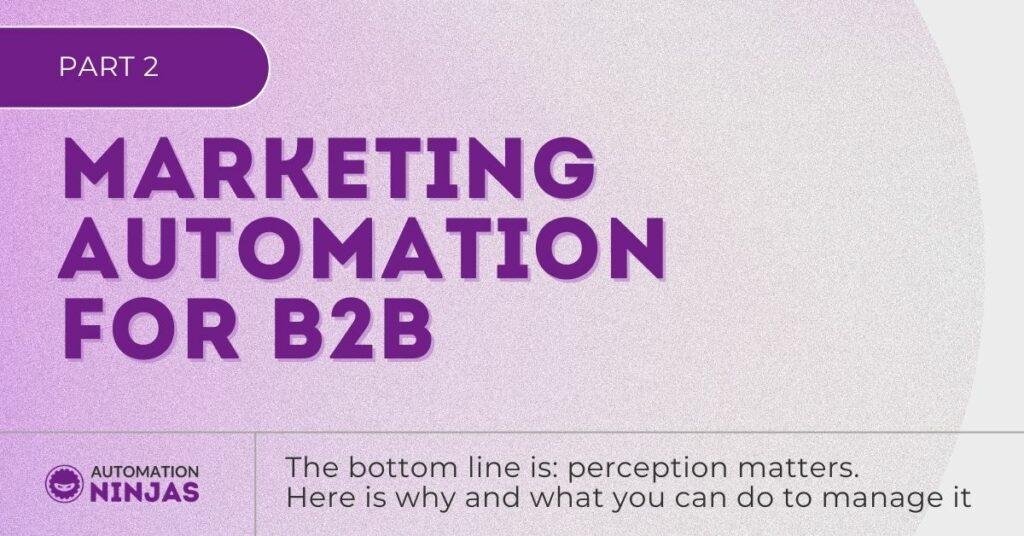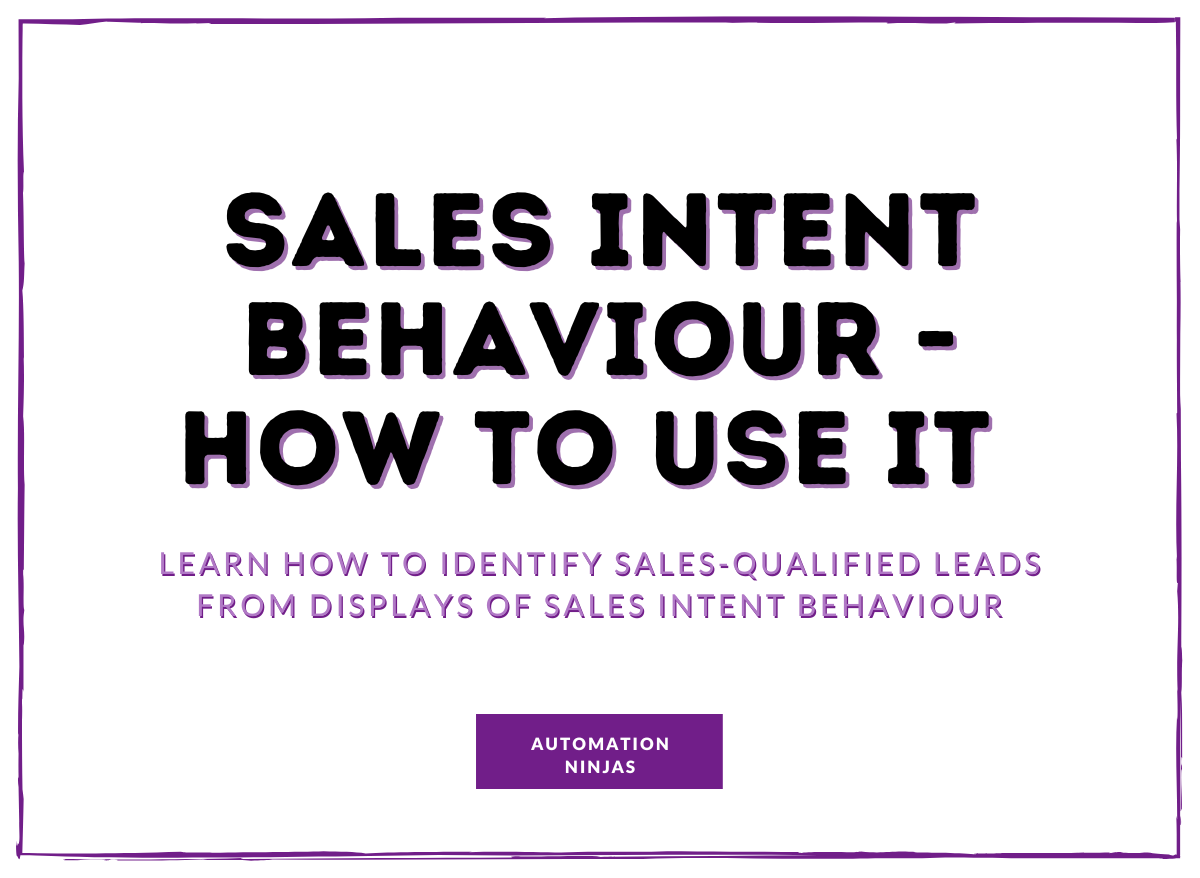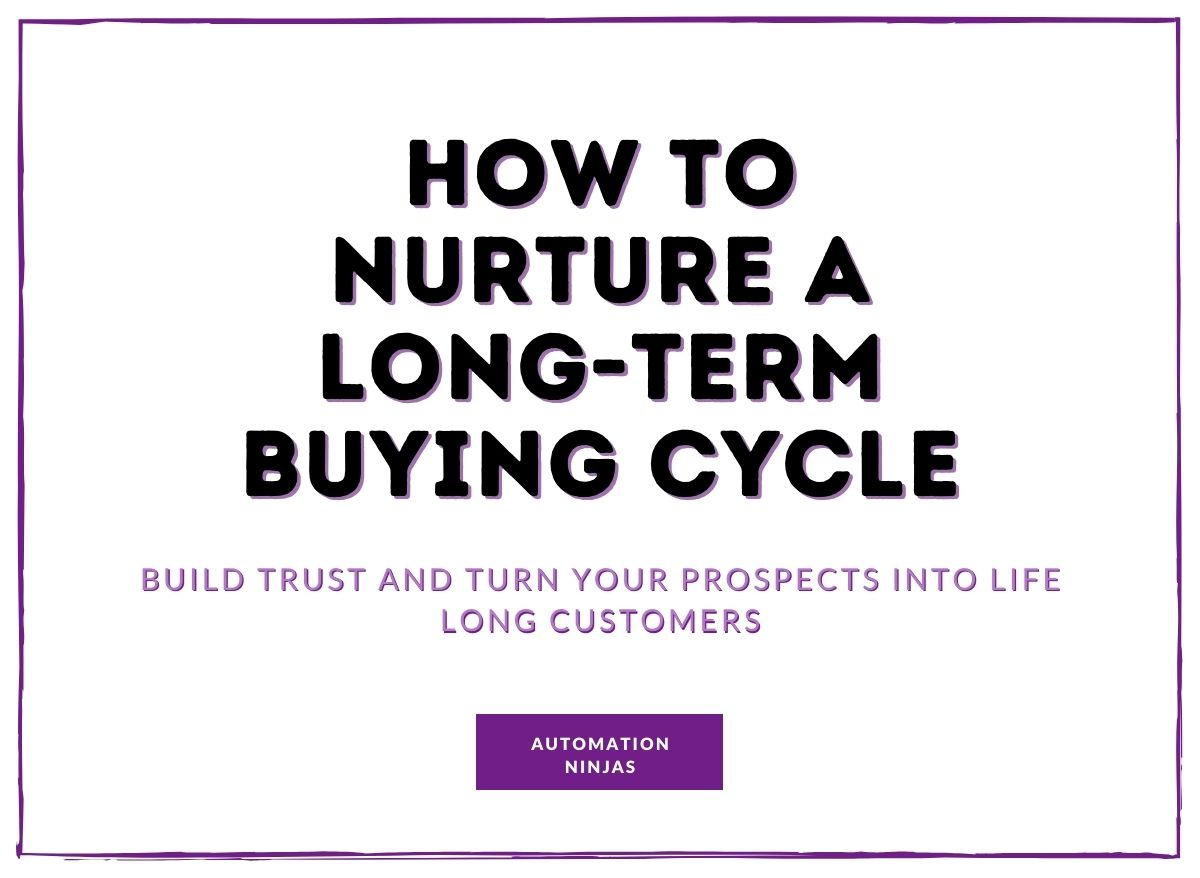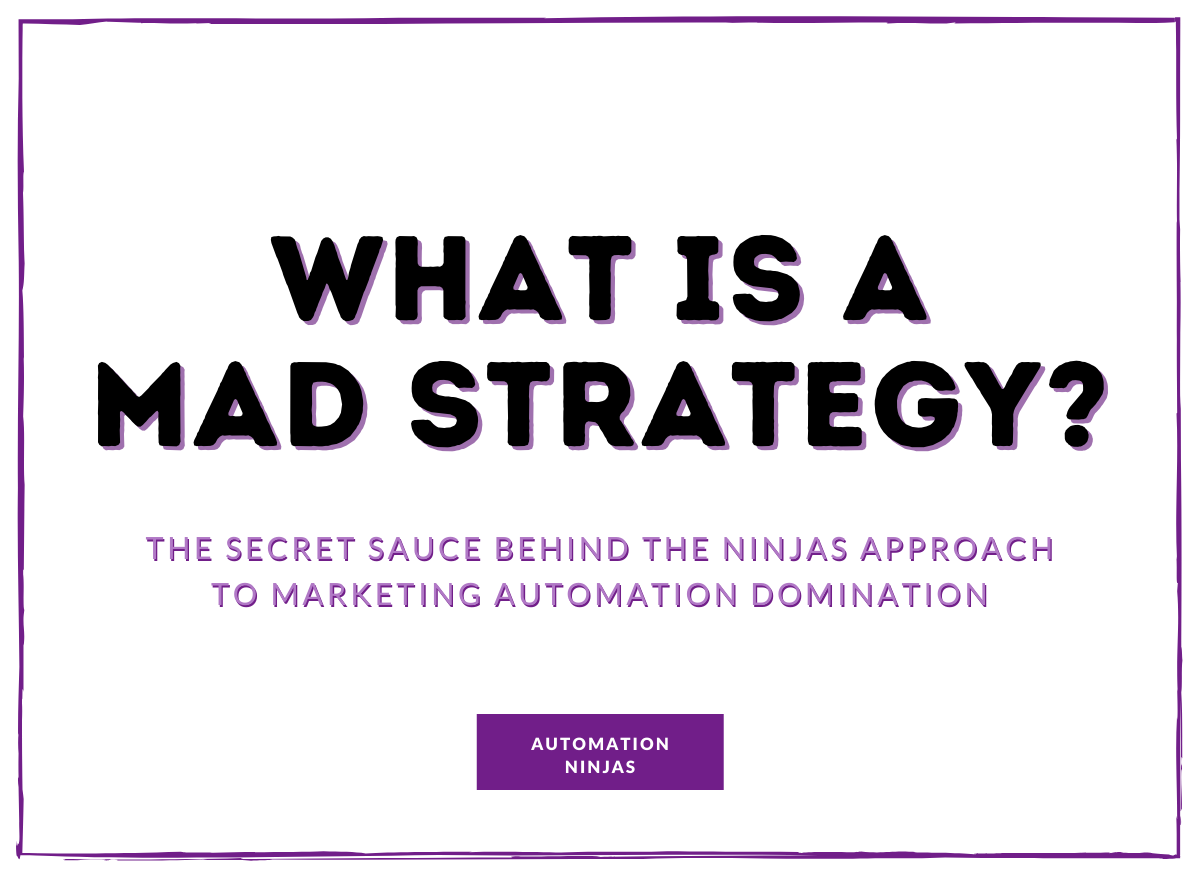Author: Ashton Oldham
Hey there, I'm Ashton, the Content Ninja with a penchant for creativity! I'm all about crafting killer customer-focused content and sprinkling it with that special sauce that makes brands pop. Teaching, strategising, organising (people and projects), and spicing up collaborations? That's my jam!
At the core of successful B2B Marketing Automation lies the customer journey. Everything you do to get and keep a customer. The automation tools and tactics are simply there to support that objective.
We’re going to get down and dirty with the customer journey, specifically the back end: Sell and Wow.
Oh yes, we have split the journey up into four key sections. It’s a tried and tested framework that works well in every B2B business (B2C, B2G, SaaS too). If you care about ROI and Customer Lifetime Value, this is the golden ticket you need to that success party!
The front end of the customer journey focuses on Attract and Engage, which I discussed in my previous blog.
Yes - this is Part 2 of the Marketing Automation for B2B series. Haven’t you read Part 1? Click here to hop on over and familiarise yourself with attracting and engaging your lovely leads.
In Part 1, we went through some basics, such as ‘What is B2B Marketing Automation’, and I listed many types. I won’t repeat it here, as I’m sure you’ve already absorbed that information (otherwise, do that now). Besides, it’s not the juiciest piece of copy to read, so once is probably enough 😉
Instead, we’re going to skip the starter and main and go straight to the pudding and aperitif:
How to get those sweet-as sales and wow your newly won customers.
Yaasss! Let’s do it!

Running before you can walk with B2B Marketing Automation…
Uh oh. A bit of a false start there (my bad.) I want to address something quickly before we dive back into the ‘how to’ pool…
In my last blog (you may remember), I mentioned that this series wouldn't be a tech-focused comparison table of automation tools on the market.
Nope. That’s not what this is. Tech should always come after your strategy. Otherwise, you could just be playing a guessing game at what automation to choose. And that could end up a pretty expensive game…
Adopting an array of automation platforms to speed up your processes or because someone in your company has told you to isn’t going to propel you forward.
That’s usually a decision made in panic mode. Many businesses suddenly realise that they have been doing things wrong or not as well as they could be.
But honestly, bringing automation into a strategy designed without it is like trying to fit a square peg in a round hole.
Redesign your strategy with automation in mind.
Your entire marketing and sales strategy should be laid out and reviewed. Marketing automation tactics will usually struggle unless a robust and well-thought-out strategy supports them. After all, you must build solid foundations for your house if you want it to stay standing for years to come.
A finely-tuned approach will also make you crystal clear on what platforms and tactics you need.
Plus, you can set data-driven goals and objectives. There’s no point in making changes to your strategy if you don’t know why you are doing something or if you aren’t going to measure your implementation's success.
Identify gaps in your strategy and your team's knowledge or skill set. Then you can look at what training is appropriate or where you may need to hire or outsource to bring that expertise into the fold.
Now that’s covered, shall we get onto the good stuff?!
How to Sell like a pro with B2B Marketing Automation
Aside from acquiring leads, the ‘sell’ stage is usually the focal point for most businesses. After all, you need to make sales to survive.
The problem we find is that many companies aren’t doing this strategically.
As we know, the B2B buying process can often be long. And there are usually a few decision-makers involved before anything gets over the line. So, when it comes to B2B, it’s customary to have a dedicated Sales team managing this process.
But, what we come across time and again is a divide between sales and marketing. Let me explain.
Often Marketers are front-end focused; they concentrate on acquiring leads for the sales team to work on. The lead comes in; the sales team gets flagged - sometimes manually, sometimes using automation if a CRM or other system is in place - and off they go to make contact.
If you ask, “where’s the problem?” I feel you’ve not read Part 1 of this blog series.
In that blog, I discussed the Attract & Engage stage in detail. This covered lead generation and content nurture and everything in-between.
We also went into Awareness, which showed how many leads start as Unaware, or Problem Aware - they’ve got a whole process to go through before becoming Most Aware. And it’s at this final stage, that we can consider a lead to be a prospect and fundamentally ready to buy.
I want to hone in on nurture. It is undoubtedly at the core of successful B2B marketing automation.
The role of ‘Nurture’ in B2B conversions
We know that 80% of leads never translate into sales.
Yet, companies that excel at lead nurture generate 50% more sales-ready leads at 33% lower cost.
When a lead comes to you, are you expecting them to be highly qualified? If not, then why would they be ready for sales?
There is no rhyme or reason for sales to receive a lead that isn’t yet Sales Qualified. Their job shouldn’t be to qualify them. Their job is to close deals.
It’s marketing that needs to take the lead from MQL to SQL. And nurturing them is the way to do it.
I just want to hop into cold vs. hot leads for a sec by sharing something I’ve nicked from one of our other blogs.
What is a Cold Lead?
They have little awareness of what you do/offer
They’re not all that interested in you
They need a lot of nurturing to progress them to a warm lead
And what is a Hot Lead?
They have a high awareness level of what you do/offer and how you do it
They are interested in your offering
They’re hot, engaged, and ready to get sales information.
PS. A highly qualified lead is considered ‘hot.’
So let’s assume that leads are coming to you cold. Which the majority of them will be. Sending them straight to sales isn’t going to work well, is it?
But, if you get them to the point of being a ‘hot’ lead, it’s far more likely sales will be able to convert them. It’s marketing’s role to warm leads up, and by nurturing them, they will get nice and toasty.

How to nurture a lead from cold to hot & ready to buy
We’ve got tonnes of blogs that focus on different ways to nurture. So, instead of taking you down a rabbit hole in this blog, I will link them below, alongside some brief context. Then you can go off and learn about each one individually (trust me, it will be worth the reading effort).
1. New Lead Welcome
This is the first engagement point with your brand. When a lead comes through your door for the first time, you must welcome them. A warm welcome kick-starts the relationship-building process, which is crucial for B2B.
A new lead welcome campaign allows you to introduce your brand, sets the tone for how you will communicate going forward, highlights the benefits of joining your list, and allows you to learn more about them.
Every business, even B2C, should have a welcome email series ready to trigger off automatically when a lead comes in.
Read ‘What is a welcome email campaign’ to learn more.
2. Long Term Nurture
Now, this one isn’t a standalone campaign in itself. It covers various campaigns - which are usually ‘evergreen’. The collective goal is to nurture over a long period consistently.
As most B2B businesses have a long buying cycle, long-term nurture is necessary to support that timeline.
The campaigns should be:
- Educational
- Offer tonnes of added value
- Help to strengthen the relationship with your brand
- Provide data on who your lead is
- Inform you of what each lead wants and needs from a solution.
(Then you can be sure to provide the right one).
I’ve got a couple of blogs to share with you around long-term nurture, as it is so flippin’ important for your MQL>SQL strategy:
- What is a long-term nurture email campaign?
- How to do lead nurturing successfully (a real-life example)
3. Short Term Nurture
In contrast to the above, short-term nurture campaigns are standalone. They have one purpose, and that job is usually to follow up.
If a lead has signed up for a lead magnet/piece of gated content, completed a contact form, etc., you must follow up with relevant and specific nurture.
Each campaign will have one goal, guided by the reason for following up in the first place.
Learn more by reading ‘What is short-term nurture marketing.’
4. Re-engagement
Let’s face facts, we all have to deal with some leads and customers becoming unengaged at one point or another. The problem is, if we don’t try to re-engage these sleepy people on our lists, we stand a higher chance of them ultimately unsubscribing.
Unfortunately, we won’t win them all. Some subscribers might not be suited to your offering even if you thought they were initially a good lead. We need to weed out those people, our non-ideal customers. But the ones who have the potential to become lifelong customers - well, we need to get them back in the game. Say hello to the Re-engagement campaign (a form of short-term nurture).
Read ‘How to create a re-engagement campaign’ for all the insights
5. Motivation Sales Series
Now I know what you’re thinking, “nurture shouldn’t include sales, right?!”. And, yes, for the most part, we treat the two separately. But a motivational sales series is slightly different.
Kenda, our head honcho and very expert Ninja, created the motivational sales series for a specific purpose: to nurture and motivate a lead further down the funnel - in the Most Aware stage.
Our motivational sales series comprises high-value content that nurtures a prospect and gets them ready to buy - or at least speak to sales. It supports sales teams incredibly well. Demonstrating all the reasons to buy - in a benefit-focused way, addresses purchasing objections, and showcases others using the product or service. (As a minimum).
Now - we don’t have a whole blog about this series. As it’s a product we offer, it would be silly of us to give away the recipe for free (yes, we need to make money too!). But we have lots of great content you can have free of charge to support you with sales emails.
- How to create an amazing offer (that sells itself)…
- How to upsell, cross-sell and downsell
- How to implement a sales sequence that gets results
- Sales campaigns: what is the right and wrong way to do them?
Marketing’s pivotal role in sales for B2B businesses
That’s a whole heap of info about nurturing for sales. I hope you can see the crucial role marketing teams must play in supporting sales rather than working in a front-end-only capacity.
Getting a lead from MQL to SQL takes work and can take a lot of time.
You must drip-feed your leads with content throughout that journey to keep them engaged and move them through the awareness stages. Then continue to drip motivational sales content to help sales nudge them over the line.
If you don’t have a content plan to support this, I suggest you block some time out to get going with one.
Not sure where to start?
Fortunately, we’ve got a heap of information and tips to support you with content planning and creation. Check out How to plan strategic content for your marketing automation and How to create a content plan, for starters.
Does B2B Marketing Automation stop at conversion?
So, we’ve covered B2B marketing automation for selling in a nutshell. It’s not as straightforward as e-commerce; you really do have to put the work in with those leads.
But what happens when they convert? Surely marketing can take a backseat now?
Nope - the work is never done (sorry, not sorry).
If you want to achieve excellent Customer Lifetime Value (CLV) and retain customers for the long term, you need to wow them from the get-go.
Their customer relationship should start strong and continue that way - let me explain.
You need to Wow your new customers to increase CLV

Owen Wilson saying "wow"?!… If you know, you know.
If you’ve put effort into the previous three stages of the Lifecycle Marketing framework, it would be a shame to drop the ball on the last stage. We are talking about wowing your newly acquired customers - knocking their socks off.
How do we do this?
It’s pretty simple. We continue to nurture and add value with marketing automation!
To start with, you want to onboard your new customers. Make them feel as though they have made the best decision.
Have you ever heard of buyers' regret? It’s prevalent in eCommerce, but it also exists for B2B. There’s also post-purchase apathy, which is just as bad as regret.
If a new customer feels apathetic after committing to your product or service, it will be a real struggle to make them happy and keep them that way. They’ll likely soon be looking for an alternative to fill that void. Plus, they won’t be jumping at the bit to promote your company - instead, they could leave poor reviews, damaging your brand.
Jeez. What a downer.
Fear not! If you’re strategic and use your marketing automation for all its worth, you can avoid the doom and gloom mentioned above.
Step 1: Get clear on your Buyers’ Consumption journey
To start, you should be aware of the buyers’ consumption journey. It looks something like this:
- 1- Research - how others use their purchase, reading user guides, etc.
- 2- Implementation (using) - first time trying out the product or service.
- 3- Proving - does it do as promised? Was it worth the investment (cost)?
- 4- Optimisation (owning) - finding their way to use it and refining their opinion on it.
- 5- Enjoying - feeling good about the purchase, perhaps even telling others about it.
Knowing each of these steps can help you prepare for them. For example, do you need to create user guides, provide product training, offer implementation support, etc.?
Do you have an excellent customer support system to ensure any concerns are dealt with efficiently and solutions delivered? Are you promoting this service and making it easy for them to access?
Step 2: Provide an incredible Onboarding experience
You know how I said (in Part 1 of this blog series) that when you acquire a new lead, you need to welcome them into the fold? It’s the same sort of thing for a new customer.
In this case, we call it “onboarding.”
90% of customers think that companies could “do better” when it comes to user onboarding. (Wyzowl)
Yikes to that statistic.
But it’s so true. Think about your purchases - are you being onboarded well most of the time?
You need to onboard your customers, and marketing automation can help.
Create an onboarding campaign that triggers once a lead has converted, and fill that immediate space of time after purchase. In turn, you’ll lessen the chance of post-purchase apathy or remorse.
Onboarding campaign goals:
- 1- Welcome your new customers warmly and authentically.
- 2- Re-enforce who you are and why you're the right choice.
- 3- Give them value to outweigh the pain of purchasing.
- 4
- Familiarise them with communications and start a consumption routine.
- 5- Get your customers using/consuming and loving your product/service.
- 6- Wow your customers with excellent aftercare.
What does that look like in email format?
For B2B, we suggest three to four detailed emails - though you could add a couple extra if the content within them is valuable.
Email 1 - Welcome and thank them for choosing you. Set the scene - what does being a customer look like, and what can they expect going forward? Do you need to book something with them - perhaps a call or in-person meeting/implementation? Get them excited about their future working with you.
Email 2 - Provide purchase-specific nurture. Remind them of what they have purchased and why they did so (problems & benefits). Combat that post-purchase apathy or regret by cementing their decision to buy from you. This email is a great place to link user guides, don’t leave it up to them to hunt for helpful info.
Email 3 - Introduce the people they will be working with now they are a customer. Do you have a specific customer support system in place? Let them know how to access this and what the benefits are. Building relationships from the start is so important!
Email 4 - Let them know how they can make the most of being a customer. Don’t just expect them to be savvy to this; spell it out. Is there anything they need to do right now? Send them off to consume useful information or do some homework - make sure you highlight why this is important and beneficial.
For more information, check out What should every Onboarding campaign contain? And, Everything you need to know about our onboarding campaign project.
Increase CLV with B2B Marketing Automation
Onboarding customers is the first step to increasing CLV. You should continue to engage and nurture your customers to retain them.
Customer retention is crucial for the success of B2B businesses.
Research by Bain & Company states, “a 5% increase in customer retention produces more than a 25% increase in profit. Why? Return customers tend to buy more from a company over time. As they do, your operating costs to serve them decline. What’s more, return customers refer others to your company. And they’ll often pay a premium to continue to do business with you rather than switch to a competitor with whom they’re neither familiar nor comfortable.”
Of course, much of the responsibility for customer retention lies with customer success teams - account managers, customer support, product trainers and consultants, product developers, etc.
But marketing also plays a key role.
By working closely with the customer success team, marketing should identify the requirement for drip-feeding valuable information using marketing automation.
Marketers also need to recognise when an upsell/cross-sell opportunity arises. It’s a great way to increase ROI and CLV. Often these opportunities are picked up through engagement and behavioural segmentation set up in the marketing automation platform.
We are always looking for success stories in marketing to help us promote the business.
Rather than waiting for them to come to us, we should proactively reach out to acquire them. That will involve speaking to the customer success team and likely interviewing/speaking to the customer directly to get the case study from them.
Related content: How an onboarding strategy can reduce your customer churn rate.
Nail your B2B Marketing Automation strategy from start to finish
I hope after reading this blog and Part 1 of the series, you can see how crucial a role Marketing plays in the entire customer journey.
(If you’re a marketer, isn’t it nice to know just how important you are to the business?!)
So, now you have Part 1 & Part 2 to hand, it’s time for you to hoist the sails and begin your journey to B2B marketing automation awesomeness.
Get your ideal customer journey mapped out.
Look at what you need to review and implement to attract, engage, sell, and wow your customers, from generating leads and engaging them with valuable content to motivating them to buy and supporting those customers once they have converted.
It’s a nurture-heavy process for B2B, and there is much to do (especially if you start from scratch).
I know you are probably feeling a little daunted about that. You wouldn’t be the first… That’s why we are on hand to support you. If you would like us to, that is 🙂
Speak to a Ninja directly, just get in touch here.





